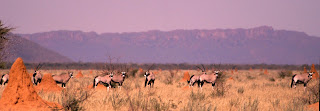 |
| The CCF Clinic Team displaying some of the items donated by Mark C. |
Anne's latest boxes included syringes, catheters, injectable solutions and antiseptics, binoculars, a portable weather station and darts, among other things. She has also sent us general office supplies, books and compasses.
Mark has been incredibly generous since his first visit to CCF last year, when he personally delivered radios, cameras and computing equipment, to name only a few. That was followed by a brand-new portable ultrasound machine! This time he sent us a microscope that will allow us easy and quick diagnoses of diseases and oestrus observation in our breeding dogs, and a camera we can use to send photos for collaboration with other vets and research organizations. There was also a microscope scale slide to help us with parasite identification, as well as faecal analyzers to run parasitological worka and studies. For the dogs, Mark sent several Elizabethan collars, which are costly in Namibia and do not function very well in the kraal. With the collars donated by Mark, dogs' wounds will heal much quicker. He even sent a portable stretcher we can use for dog and cheetah work ups in the field.
I personally believe that Mark's generosity is contagious. When he approached Thames Medical (UK) to purchase an urgently- needed pulse oximeter, Thames kindly threw in blood pressure equipment at no cost. All these items will make a world of difference when monitoring cheetahs under anaesthesia! And to top it all off, Mark also sent an HP laptop computer.
Also right before the annual cheetah work ups, Debra, from the Anasazi Animal Clinic in Arizona (USA) once again sent us much-needed vaccines, while Gertrude, a pharmacist in Germany, sent us once again an impressive array of clinic supplies.
We are so grateful to Mark, Anne, Debra, Gertrude, and so many other supporters that help us by donating items from our Wish List, which are either hard to get or too expensive in Namibia. These donors either have access to some of these items through their jobs, or approach companies and encourage them to donate, or simply purchase them for us. Some others make cash donations towards specific items on the Wish List.
The CCF's Wish List includes clinic and vet equipment, the Genetics Lab, ecological research, computing equipment, cheetah exercise equipment, and we always accept books. Currently we are in urgent need for GPS collars for cheetahs and tracking collars for our scat detection dogs. If you would like to help by either making a donation toward these items, or obtaining them for us, please click here to visit our Wish List.
With cheetah purrs, and our thanks,
Patricia























